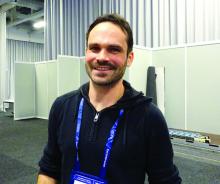BERLIN – Adults, adolescents, and children with type 1 diabetes mellitus (T1DM) achieved better glycemic control and spent less time in a hypoglycemic state with an investigational closed-loop basal insulin delivery system than with a sensor-augmented insulin pump.
The primary trial endpoint of the proportion of time spent in a target glucose range of 3.9-10 mmol/L at 12 weeks was achieved by 65% of closed-loop users versus 54% of sensor-augmented insulin-pump users (P less than .0001).
In addition, fewer patients had periods of blood glucose less than 3.9 mmol/L at 12 weeks, potentially reducing their risk for hypoglycemic episodes (2.6% vs. 3.9%, P = .0130). The percentages of patients with blood glucose concentrations higher than the target range were also significantly reduced with the closed-loop system.
Glycated hemoglobin (HbA1c) improved in both groups, from a baseline of 8% to 7.4% at 12 weeks in the closed-loop users and from 7.8% to 7.7% in the sensor-augmented insulin-pump users (mean difference –0.036%, P less than .0001). Mean glucose levels also significantly improved, with a mean between-group difference of –0.45 mmol/L (P less than .0001).
“Most of the improvements are overnight,” with a striking difference between the control and closed-loop groups of time in range, said senior study investigator Roman Hovorka, PhD, during a press briefing at the annual meeting of the European Association for the Study of Diabetes.
“Usually what people need to do is titrate insulin based on blood sugar tests, but in our system those tests are done by a monitoring system and the insulin is titrated by a computer algorithm,” study investigator Martin Tauschmann, MD, explained in an interview after the press briefing.
The prototype system consists of a modified insulin pump (Medtronic 640G) and a continuous glucose sensor (Enlite 3) that are linked by the proprietary “Cambridge control” algorithm via an Android phone. The latter calculates the optimum insulin dose, which is then relayed to the insulin pump every 10 minutes to determine how many insulin units are needed.
“The algorithm is based on mathematical modeling that is trying to predict what the glucose levels will be in the future and trying to work out the optimum insulin dose to bring the predicted glucose levels down,” noted Dr. Tauschmann, who is a pediatrician at Cambridge University (England).
It’s not a fully closed-loop system, he added, it’s a hybrid, so users still need to calculate their carbohydrate intake around mealtimes and input that into the algorithm and use bolus insulin.
“A problem with using currently available insulin formulations is that you are always behind, because we are delivering insulin in the subcutaneous tissue and it just takes some time for the insulin to be absorbed, and, in the meantime, the blood sugar levels go up,” Dr. Tauschmann observed. Studies with fully closed–loop systems, so far, have shown glucose peaking after meals. Perhaps when faster-acting insulins are tested in this setting it could work, he suggested, but perhaps simplifying how the users announce their meals is a future development for the hybrid systems.
Closed-loop insulin delivery is not a new concept. There is already one system available in the United States produced by Medtronic (670G), which was approved by the Food and Drug Administration in September 2016. However, there are no systems available in Europe and there are limited trial data on their use in an outpatient setting.
The aim of the current study, which was an open-label, multicenter, multinational, parallel-group, randomized, controlled trial, was to compare closed-loop basal insulin delivery and sensor augmented insulin pump therapy in helping a mixed adult and pediatric population of patients T1DM achieve good glucose control.
In all, 86 adults, adolescents, and children (age 6 years or older) were randomized: 46 to the closed-loop system and 40 to the control arm of sensor-augmented insulin pump therapy. The mean age of participants was 22 years in the closed-loop group and 21 years in the sensor group, with a respective 24% and 30% aged 6-12 years, 24% and 20% aged 13-21 years, 39% and 35% aged 22-40 years, and 13% and 15% aged 41 years or older. The mean duration of diabetes was 13 and 10 years, in each group, respectively.
The study data “provide more evidence that closed-loop insulin delivery, compared with standard pump and sensor, really improves HbA1c, time spent in range, and mean glucose, and it also reduces hypoglycemia,” Dr. Tauschmann said.
“We didn’t have any real safety issues,” noted Dr. Hovorka, who is professor and director of research in the department of pediatrics at the University of Cambridge. There was one episode of diabetic ketoacidosis caused by infusion set failure in the closed-loop group; 16 other adverse events were noted (13 in the closed-loop group, three in the control group) that were not related to treatment.
“We have a number of studies in the pipeline,” Dr. Hovorka said. “Two exciting studies are in development. In one we are recruiting 70 subjects with newly diagnosed type 1 diabetes mellitus who will be treated with a closed-loop system. There is also a study in children aged between 1 and 7 years that is projected to start next year.”
Work is also underway to create a platform that will work with all insulin pumps and create a commercial product.
The study was funded by the Juvenile Diabetes Research Foundation with additional support from the National Institute for Health Research (England) and the Wellcome Trust. Dr. Tauschmann reported receiving speaker honoraria from Medtronic and Novo Nordisk. Dr. Hovorka reported receiving speaker honoraria from Eli Lilly and Novo Nordisk, serving on an advisory panel for Eli Lilly, receiving license fees from B. Braun Medical and Medtronic, and having patents and patent applications.
SOURCES: Tauschmann M et al. EASD 2018, Oral Presentation 19.



